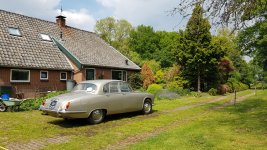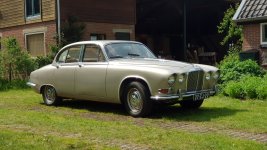Indoor storage and low mileage lead to the absence of dryness wrinkles on the walls, even after many many years. This year I decided to fully treat my wheels on one of my old ladies (DKW 1000). Tires (Vredestein) were 30 years old and had inner tubes. No wrinkles on the walls, rubber not stiff and profile only halfway. Last summer I drive a few hours on a German freeway back home from a DKWmeeting. So still good. But these I replaced of course mainly because of the occasion of the cosmetic wheelreconditioning/powdercoating...but surely also because I didn't trust the inner tubes which condition one cannot judge from the outside. I mounted the new tires tubeless!
My Pontiac 8 2door hardtop 1954, has 40 year old diagonal tires with inner tubes. These inner tubes must be made of natural rubber because in almost 20 years ownership, to be sure I checked pressure only 2, max 3 times and I added only a small airpuff that wasn't even really needed. Mind you, aircrafttires are made of natural rubber because that's the best. The rubber of these 40 years old diagonals isn't very soft anymore but I'll keep her on 50/55 mph max (no drynesswrinkles on the walls).
Some brands use rubber that hardens earlier than others. Poke a little with a screwdriver into the surfacerubber to feel the flexibility of the rubber. When it gives some way, drive on

Brakefluid DOT 3, 4 and 5.1 I strictly refresh totally every 2 years.
One car I converted to silicon. DOT5. See you in 5 years

.
My Citroëns (DS, CX, CV6 already have green mineral brakefluid, LHM. Smart people, these French Citroënists, to NOT use DOT 3, 4, 5.1.

 Hi Guest!
Hi Guest!

 smilie in place of the real @
smilie in place of the real @
 Pretty Please - add it to our Events forum(s) and add to the calendar! >>
Pretty Please - add it to our Events forum(s) and add to the calendar! >> 



